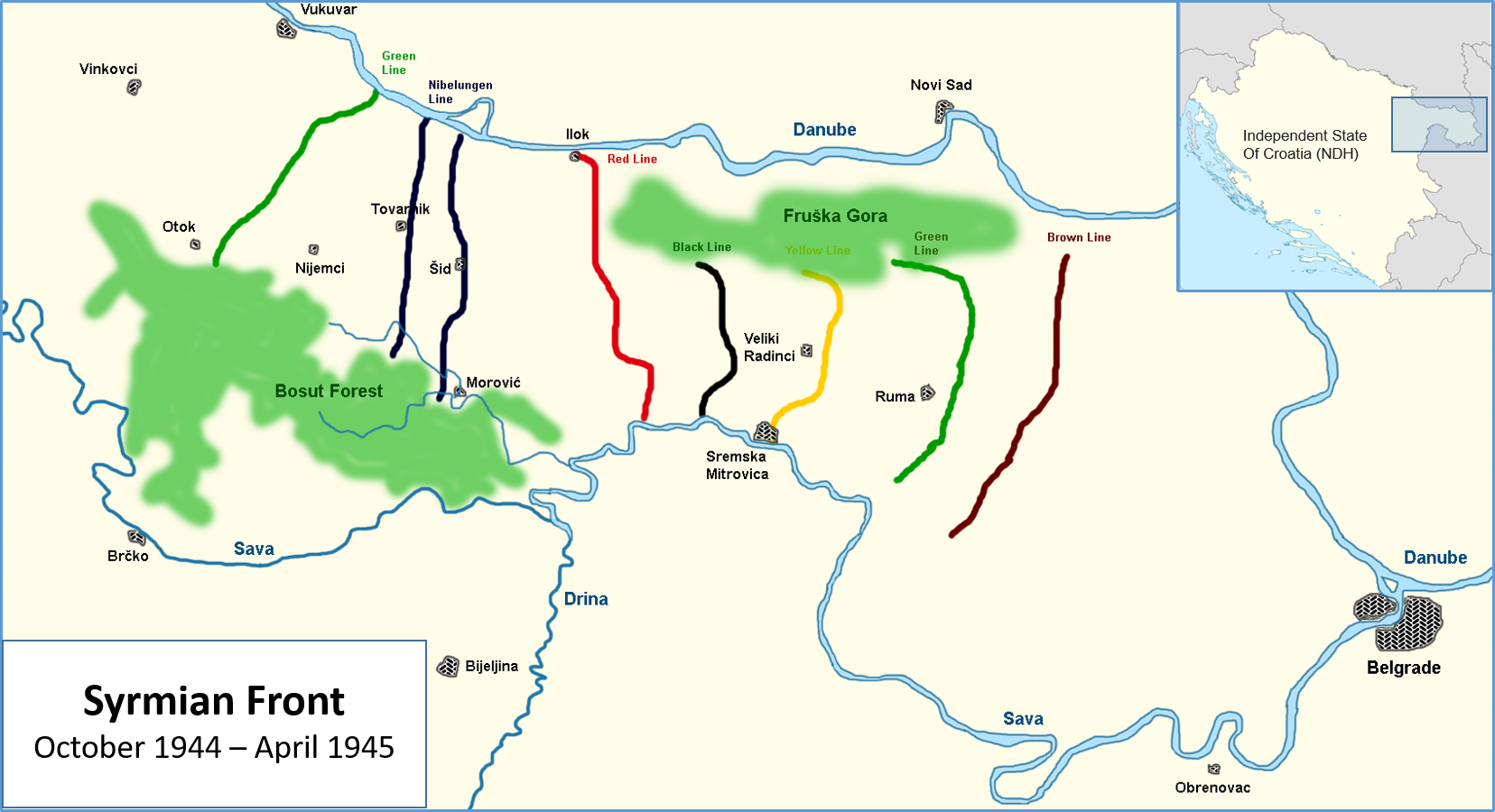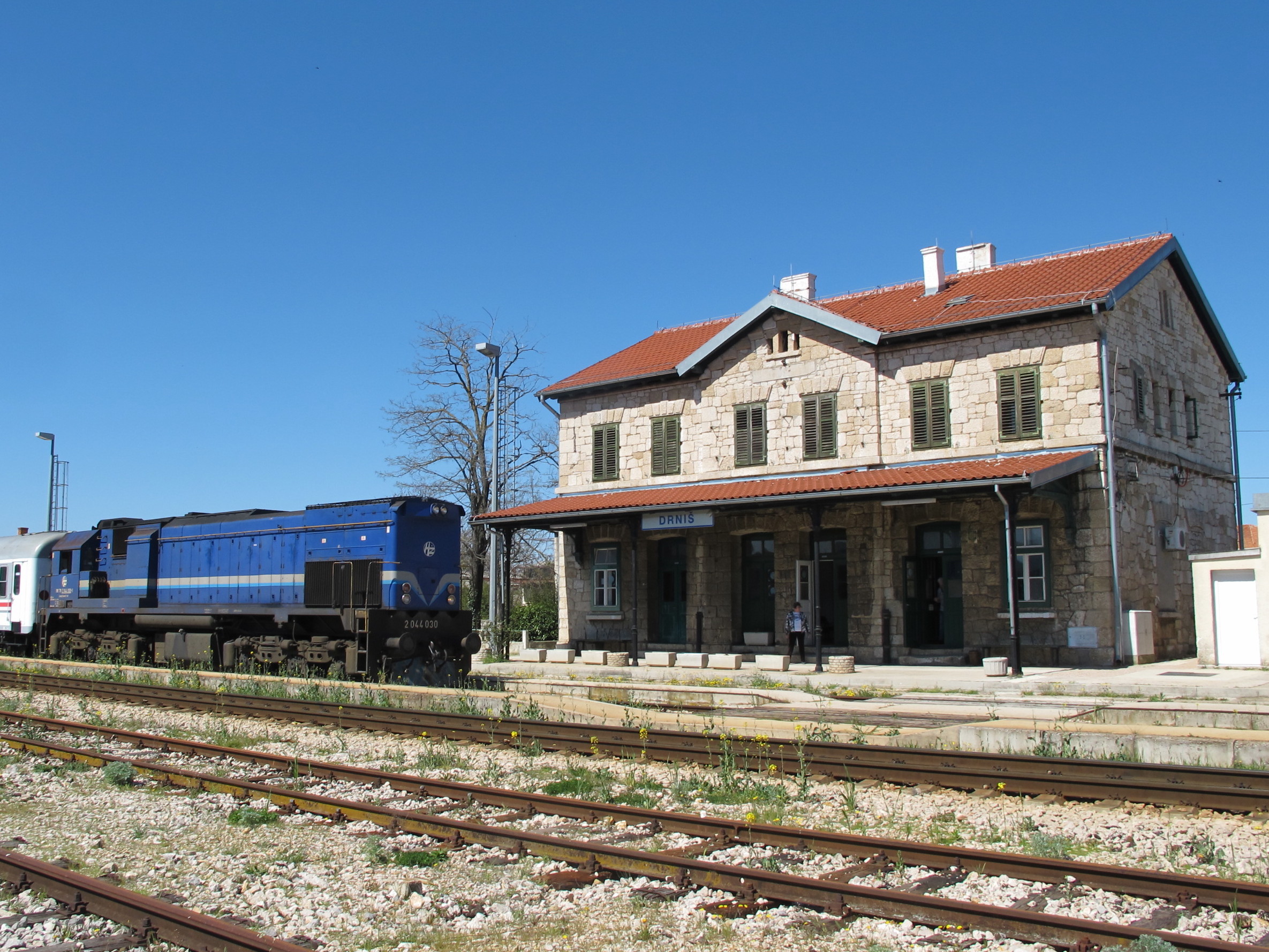|
Battle Of Knin
The battle of Knin () was a major Yugoslav Partisan operation during World War II in Yugoslavia launched by the 8th Dalmatian Corps from 7 November to 9 December 1944 with the purpose of destroying German, Ustaše and Chetnik formations in North Dalmatia and the city of Knin, then part of the Independent State of Croatia. It was the final part of the 8th Corps offensive for the liberation of Dalmatia which began on 12 September 1944. The Knin operation had three phases: Initial battles on approaches to Knin from 7 November to 25 November, main battle and liberation of Knin from 26 November to 4 December, and final battles and pursuit of retreating Axis forces to Otrić in Lika from 5 December to 9 December. Background Following the liberation of Šibenik and Drniš, the forces of the 26th Division pursued the Germans towards Knin, but met fierce resistance south of the city. Soon the Command of the 8th Corps started grouping its forces for the attack on Knin. Since the Axis los ... [...More Info...] [...Related Items...] OR: [Wikipedia] [Google] [Baidu] |
World War II In Yugoslavia
World War II in the Kingdom of Yugoslavia began on 6 April 1941, when the country was Invasion of Yugoslavia, invaded and swiftly conquered by Axis powers, Axis forces and partitioned among Nazi Germany, Germany, Fascist Italy (1922–1943), Italy, Kingdom of Hungary (1920–1946), Hungary, Kingdom of Bulgaria, Bulgaria and their Client state, client regimes. Shortly after Operation Barbarossa, Germany attacked the USSR on 22 June 1941, the League of Communists of Yugoslavia, communist-led republican Yugoslav Partisans, on orders from Moscow, launched a guerrilla liberation war fighting against the Axis forces and their locally established Puppet state, puppet regimes, including the Axis-allied Independent State of Croatia (NDH) and the Government of National Salvation in the Territory of the Military Commander in Serbia, German-occupied territory of Serbia. This was dubbed the National Liberation War and Socialist Revolution in post-war Yugoslav communist historiography. Simulta ... [...More Info...] [...Related Items...] OR: [Wikipedia] [Google] [Baidu] |
Knin
Knin () is a city in the Šibenik-Knin County of Croatia, located in the Dalmatian hinterland near the source of the river Krka (Croatia), Krka, an important traffic junction on the rail and road routes between Zagreb and Split, Croatia, Split. Knin rose to prominence twice in history, as the capital of both the Kingdom of Croatia (925–1102), medieval Kingdom of Croatia and briefly of the self-proclaimed Republic of Serbian Krajina within the newly independent Croatia, Republic of Croatia for the duration of the Croatian War of Independence from 1991 to 1995. Etymology The name is likely derived from the Illyrian language, Illyrian ''Ninia''. According to an alternative explanation, offered by Franz Miklosich and Petar Skok, the name - derived from a Slavic root ''*tьn-'' ("to cut", "to chop") - means "cleared forest". The medieval names of Knin include ; ; . The Latin name is still used as a titular see, titular episcopal see, the Diocese of Tinum. History Ancient The are ... [...More Info...] [...Related Items...] OR: [Wikipedia] [Google] [Baidu] |
19th Division (Yugoslav Partisans)
The 19th North Dalmatia Division (Serbo-Croatian Latin: ''Devetnaesta severnodalmatinska divizija'') was a Yugoslav Partisan division formed in Biovičino Selo on 4 October 1943. Upon formation it had 3,559 soldiers in three brigades, those being: the 5th, 6th and 7th Dalmatia Brigades. During all of its existence it was a part of the 8th Corps. Commander of the division was Milan Kuprešanin while its political commissar was Petar Babić. The division mostly operated in Dalmatia, Lika and Bosnia Bosnia and Herzegovina, sometimes known as Bosnia-Herzegovina and informally as Bosnia, is a country in Southeast Europe. Situated on the Balkans, Balkan Peninsula, it borders Serbia to the east, Montenegro to the southeast, and Croatia to th .... References {{WWII-stub Divisions of the Yugoslav Partisans Military units and formations established in 1943 History of Dalmatia Croatia in World War II ... [...More Info...] [...Related Items...] OR: [Wikipedia] [Google] [Baidu] |
9th Division (Yugoslav Partisans)
The 9th Dalmatia Division (Serbo-Croatian Latin: ''Deveta dalmatinska divizija'') was a Yugoslav Partisan division formed in Imotski on 13 February 1943. Upon formation it was composed of the 3rd, the 4th and the 5th Dalmatia Brigades. The division fought NDH, Germany, Italy and Chetniks in various operations conducted by the Partisans, it played a key role in the Trieste operation The Race for Trieste (), also known as the Trieste Operation (), was a battle during the Second World War that took place during early May 1945. It led to a joint allied victory for the Yugoslav Partisans and 2nd New Zealand Division and a joint .... It was commanded by Ante Banina and its political commissar was Eduard Santini. References {{WWII-stub Divisions of the Yugoslav Partisans Military units and formations established in 1943 History of Dalmatia Croatia in World War II ... [...More Info...] [...Related Items...] OR: [Wikipedia] [Google] [Baidu] |
Banja Luka
Banja Luka ( sr-Cyrl, Бања Лука, ) or Banjaluka ( sr-Cyrl, Бањалука, ) is the List of cities in Bosnia and Herzegovina, second largest city in Bosnia and Herzegovina and the largest city in Republika Srpska. Banja Luka is the traditional centre of the densely forested Bosanska Krajina region of northwestern Bosnia (region), Bosnia. , the city proper has a population of 138,963, while its administrative area comprises a total of 185,042 inhabitants. The city is home to the University of Banja Luka and University Clinical Center of the Republika Srpska, as well as numerous entity and state institutions for Republika Srpska and Bosnia and Herzegovina, respectively. The city lies on the Vrbas (river), Vrbas river and is well known in the countries of the Socialist Federal Republic of Yugoslavia, former Yugoslavia for being full of tree-lined avenues, boulevards, gardens, and parks. Banja Luka was designated European city of sport in 2018. Name The name ''Banja Luka' ... [...More Info...] [...Related Items...] OR: [Wikipedia] [Google] [Baidu] |
Sarajevo
Sarajevo ( ), ; ''see Names of European cities in different languages (Q–T)#S, names in other languages'' is the Capital city, capital and List of cities in Bosnia and Herzegovina, largest city of Bosnia and Herzegovina, with a population of 275,524 in its administrative limits. The Sarajevo metropolitan area with its surrounding municipalities has a population of 592,714 people. Located within the greater Sarajevo valley of Bosnia (region), Bosnia, it is surrounded by the Dinaric Alps and situated along the Miljacka River in the heart of the Balkans, a region of Southeastern Europe. Sarajevo is the political, financial, social, and cultural centre of Bosnia and Herzegovina and a prominent centre of culture in the Balkans. It exerts region-wide influence in entertainment, media, fashion, and the arts. Due to its long history of religious and cultural diversity, Sarajevo is sometimes called the "Jerusalem of Europe" or "Jerusalem of the Balkans". It is one of a few major Europea ... [...More Info...] [...Related Items...] OR: [Wikipedia] [Google] [Baidu] |
Albanian Kingdom (1943–44)
Albania was German-occupied Europe, occupied by Nazi Germany between 1943 and 1944 during World War II. Before the armistice between Italy and Allied armed forces, armistice between Italy and the Allied armed forces on 8 September 1943, Albania had been in a ''de jure'' personal union with and was de facto under the control of the Fascist Italy (1922–1943), Kingdom of Italy. After the armistice and the Italian exit from the Axis, German military forces entered Albania and it came under German occupation, creating the client-state, the Albanian Kingdom (Albanian language, Albanian: ''Mbretëria Shqiptare''; German language, German: ''Königreich Albanien''). The Germans favoured the nationalist Balli Kombëtar over King Zog's Legality Movement, Legalists and the occupation was marked by collaboration between them and the Germans. Albania under German occupation retained control of the areas it had received during Italian rule, including most of Kosovo, as well as Western Macedo ... [...More Info...] [...Related Items...] OR: [Wikipedia] [Google] [Baidu] |
Hellenic State (1941–44)
Hellenic State (), also translated as Greek State, was used as the official name of the modern Greek state three times in its history: * First Hellenic Republic during the period of governance by Ioannis Kapodistrias in 1828–1832, when Greece was first constituted as a regular state after the Greek War of Independence. *The first few months of the Second Hellenic Republic The Second Hellenic Republic is a modern Historiography, historiographical term used to refer to the Greece, Greek state during a period of republican governance between 1924 and 1935. To its contemporaries it was known officially as the Hellenic ..., after which the name was changed to ''Hellenic Republic'' on 24 May 1924. * Hellenic State, during the period of Axis occupation (1941–1944) of the country during World War II, when the pro-Axis government renamed the country in opposition to the pro-Allies Kingdom of Greece, which remained in exile in Egypt. {{set index Political history of Greece ... [...More Info...] [...Related Items...] OR: [Wikipedia] [Google] [Baidu] |
Syrmian Front
The Syrmian Front () was an Axis powers, Axis line of defense during World War II. It was established as part of the Eastern Front (World War II), Eastern Front in late October 1944 in Syrmia and east Slavonia, northwest of Belgrade. After the Yugoslav Partisans and the Red Army expelled the Germans from Belgrade in the Belgrade Offensive, the retreating Wehrmacht and the Croatian Armed Forces (NDH), Croatian Armed Forces used fortifications to protect the withdrawal of German Army Group E from the Balkans. With help from their Soviet allies, the Yugoslav Partisans, Partisans (by then recognized as the Yugoslav army), joined by Bulgaria during World War II#Allies (1944–1945), Bulgarian and Italian partisans, Italian forces, fought a difficult winter campaign and finally broke through the front on 12 April 1945. After the Syrmian front was broken, occupied Yugoslavia was liberated. Operative background and significance After the September advance through Romania and Bulgaria ... [...More Info...] [...Related Items...] OR: [Wikipedia] [Google] [Baidu] |
Bosnia (region)
Bosnia ( sh-Latn-Cyrl, separator=" / ", Bosna, Босна, ) is the northern region of Bosnia and Herzegovina, encompassing roughly 81% of the country; the other region, the southern part, is Herzegovina. The two regions have formed a geopolitical entity since medieval times, and the name "Bosnia" commonly occurs in historical and geopolitical senses as generally referring to both regions (Bosnia and Herzegovina). The official use of the combined name started only in the late period of Ottoman rule. Geography Bosnia lies mainly in the Dinaric Alps, ranging to the southern borders of the Pannonian plain, with the rivers Sava and Drina marking its northern and eastern borders. The area of Bosnia comprises approximately 39,021 km2, and makes up about 80% of the territory of the present-day state of Bosnia and Herzegovina. There are no true borders between the region of Bosnia and the region of Herzegovina. Unofficially, Herzegovina is south of the mountain Ivan planina. A ... [...More Info...] [...Related Items...] OR: [Wikipedia] [Google] [Baidu] |
Drniš
Drniš is a town in the Šibenik-Knin County, Croatia. Located in the Dalmatian Hinterland, it is about halfway between Šibenik and Knin. History The name Drniš was mentioned for the first time in a contract dated March 8, 1494. However, there are traces of an older Middle Ages' fortress built by Croatian aristocrat family Nelipić at the site called Gradina dominating the landscape. The town was conquered by the Ottoman Empire, Ottoman Turks in 1522 due to its strategic location. Many buildings from this time period are still preserved today. During the Baroque period, the mosque built by the Turks was transformed into a church. During Ottoman rule, it was nahiya seat of Petrovo Polje (Croatia), Petrovo Polje; which initially bounded to Croatian vilayet of Sanjak of Bosnia between 1522 and 1537, laterly to Sanjak of Klis, Sanjak of Kilis between 1537 and 1664 and again between 1670 and 1683. Venetian Republic briefly conquered Drniš in 1664 during Cretan War (1645–1669), C ... [...More Info...] [...Related Items...] OR: [Wikipedia] [Google] [Baidu] |



